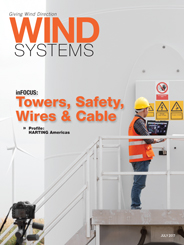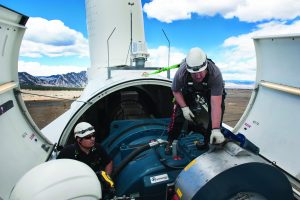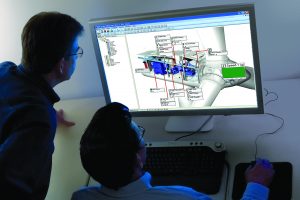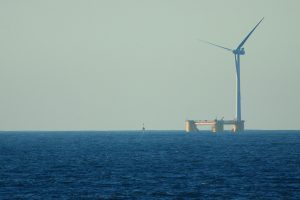Jim Patterson, manager of the FAA’s airport safety R&D section at the William J Hughes Technical Center in Atlantic City, New Jersey, talks about obstruction lighting control for wind turbines.

Lundquist: There are some people who object to the wind-turbine aircraft warning lights at night. There is technology that allows the lights to remain off unless an aircraft approaches. What can you tell me about the status of the FAA approving solutions for aircraft warning-light controls for wind farms?
Patterson: Back several years ago, the FAA was first approached by a Norwegian company called OCAS, which stood for Obstruction and Collision Avoidance System. They had a relationship with the FAA regarding some lighting at power-line crossings probably going back 10 years ago or so. So we were familiar with this company, OCAS. The company was very involved at the local level in a lot of these wind-rich states where they knew that wind-turbine vendors would be hunting for property on which they could build their turbines. And what ultimately happened is the company was able to convince a lot of these local municipalities to write into their siting criteria that anybody who wants to build a wind turbine within their jurisdiction must use an OCAS-type system. And that caused a lot of problems at that point because OCAS had not yet demonstrated to the FAA that its technology was even worthy of performing the task. A lot of local municipalities made these agreements, put it into their local laws, and then once they did, they found out the FAA had not even looked at any of these vendors, and there were no vendors to select from. And so a lot of people have been waiting anxiously for us to finish our research, so they know who the approved vendors are. The FAA is not making these mandatory. They’re not an FAA system. We simply provided, through our research, a set of performance standards, so if a wind-turbine developer were to incorporate one of these technologies into their obstruction-lighting plan, then we would want it to perform in a manner such that we have stated in our advisory Circular 70/7460-1L.
Lundquist: Vermont’s Renewable Energy Bill (S.260/Act 174) of June 9, 2016, states: “Where required by the Federal Aviation Administration, wind-energy facilities with four or more turbines must have radar-controlled obstruction lights.”
Patterson: Since I’m in Atlantic City and kind of a betting man, I would bet that OCAS probably had something to do with that back a couple years ago. I just want to make it clear that the FAA in no way is making this mandated or a requirement. We have the rules, and if you’re going do it, this is how you do it. And depending on the wind turbine’s proximity to any low-altitude flying route or airport, we may have to disapprove obstruction lighting control just based on the obstruction’s location. So it’s important to know that not all applications will be approved — it is very site-specific.

Lundquist: Which systems are approved?
Patterson: We did conduct an evaluation of OCAS’ system at a wind-turbine farm up in Talbot, Ontario. We went up there to evaluate one of OCAS’ systems they installed. And we conducted our evaluation using a helicopter, and we found the detection distance wasn’t quite what we were looking for. It was only able, at that time, to detect us about a mile and a half out. We felt that at a reasonable speed you could expect from a small general-aviation aircraft traveling that close to the ground, that it wasn’t enough time for a pilot to acquire the lights, recognize what he or she is looking at, and take the evasive action to avoid the obstruction. So we started doing work to back that up and found three miles is the requirement we have for forward visibility for visual flight rules. That ties to everything the FAA has ever looked at historically — the pilot needs about three miles to acquire something, understand, process what it is, and then move the aircraft to avoid it. With that three-mile distance in mind, we worked with a company called Laufer Wind Group out of New York City, and we were able to facilitate an evaluation of their technology with the Department of Energy at the National Renewable Energy Lab, or NREL, in Boulder, Colorado. Laufer was able to install its sensors on some prototype wind turbines out in Boulder, and we used an aircraft to fly and validate the system to prove it met the standards we had put down. We published that report on our website. We also started working with a company called Terma on their obstruction lighting control, or OLC. The company has heavy ties to military, and its technology is quite proven for port and harbor protection in its ability to find small vessels, ships, and any type of movement that might be on a body of water. It’s a long-range sensor, and a little bit bigger than the Laufer system as far as the sensor requirements. But all-in-all, we were able to facilitate a demonstration of that out in Mojave, California. That solution has been approved, and that report is now published and available on our website as well. So, as of right now, we’ve got two technologies out there: the Laufer system and the Terma system. Those research reports are finished and available on our website.
Lundquist: There’s another company, DeTect, which claims to be approved.
Patterson: They are not yet approved, so to speak. We have been working closely with them, and we actually conducted our evaluation right in northern New Jersey, up in Andover. We actually just completed our flight test on a power-line crossing with them just a few months ago, and that report is still being worked on. So once we’re done with that, their report will be out, and they would be the third approved vendor.

Lundquist: Any others?
Patterson: OCAS ended up being acquired by Vestas North America — one of the largest wind-turbine companies out there. They have a new team of engineers that has totally overhauled the system and has corrected all of the issues. So we were able to successfully negotiate with them to try to come up with a test site and were invited over to Braderup, Germany, to conduct our performance assessment. We were successful with our effort in Germany, and as of right now, we are working with the vendor to facilitate an installation here in the U.S. so we can verify the system meets our domestic frequency requirements. We’re trying to be accommodating. We already have completed the report with data and information from the assessment in Germany and will plug in the remaining information when it becomes available. Once done, Vestas will be the fourth approved vendor.
So as of right now — I hate to use this term — we only have four vendors on our radar.
Lundquist: Thank you. Any last thoughts?
Patterson: Obstruction lighting control has some good benefits. It prevents birds from being attracted to our FAA obstruction lighting, so it’s got a very positive impact on wildlife. And it helps the nearby communities to be more acceptable to renewable energy. And we’ve proven that it still has the range we need to keep aircraft safe and let pilots still see the same lighting configuration they would see with or without the technology. It could be considered a more expensive “switch” to turn the aircraft warning lights on and off, and that’s true, but it seems to be a solution that’s really helping all parties involved.
FAA research papers are available at www.airporttech.tc.faa.gov/Download/Airport-Safety-Papers-Publications

































